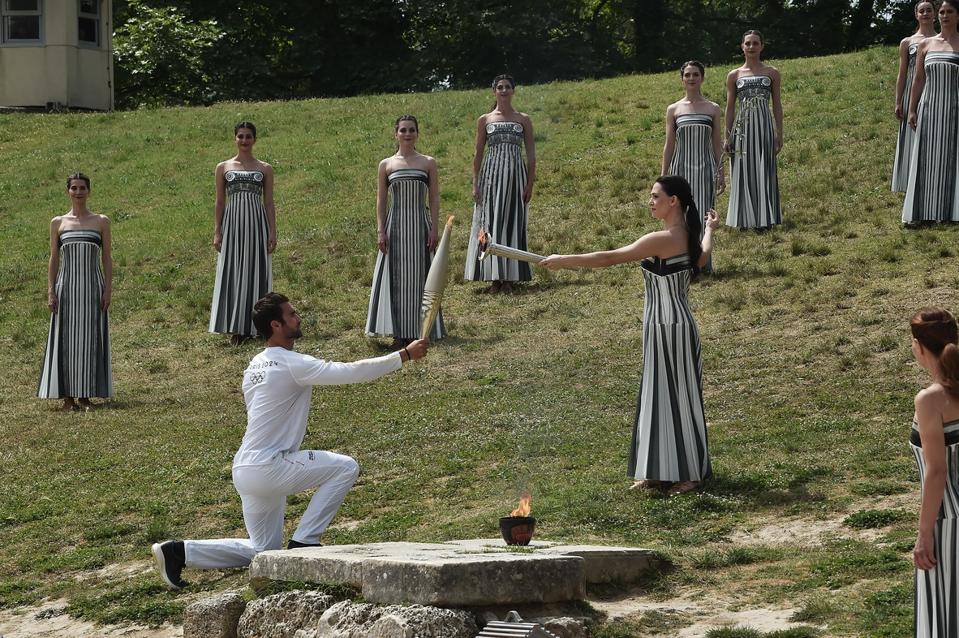With the debut of the Paris Olympics less than 100 days away, the countdown has started to the world’s foremost sports competition in which more than 200 teams, representing sovereign states and territories, will participate. A symbol of peace and friendship among nations since antiquity, the Olympic flame was lit by the sun’s rays on April 16, 2024 in Olympia, Greece, where the ancient Olympic Games were once held. It kicked off the Paris 2024 Olympic Torch Relay, which will embark on May 8 on its epic journey across every region of France, carried by 11,000 torchbearers, before what is set to be the largest-ever opening ceremony on the River Seine on July 26. I sit down with Mathieu Lehanneur, one of France’s leading designers and the man behind the design of the Paris Olympics and Paralympics torch and cauldron, to discuss his creative journey and being part of the Olympics story.
How would you describe yourself as a designer, your design language and approach, your sources of inspiration and what do you hope to achieve at the end of the day?
I’m a designer who still doesn’t know what design is. Or more precisely where it begins and where it ends. I see design as a gray area, a territory without fixed borders. It is actually a great chance; my job is a field of endless opportunities. I feed on complex geometries from nature and rational and irrational phenomena. I want my pieces to be living beings: they seem to breathe, feel and continue to grow. I want them to be works of art and supports for reflection or meditation.
You founded your own design studio in 2001. What was your path to success like?
In 2001, I left school with a diploma, little money and no contacts. “My own studio” was my bedroom with my office at the end of my bed. That’s it. It has been a long road, but at that time, I already knew that I didn’t want to work for another designer or for a company. I wanted to be independent and free, and I was ready to learn everything and try everything.
In 2006, my diploma project entered the permanent collections of MoMA New York. The senior curator and design thinker Paola Antonelli, who had been supporting me for several years, thus introduced me to the most prestigious collection in the world. It was naturally a source of pride, but above all, the recognition of numerous research and experiments, and the energy of a lifetime.
How did your collaboration with the Paris 2024 Olympics and Paralympics come about and why did you participate in the competition?
I do hate contests. You did not choose your friends by competition; you choose them for who they are, possibly for what they did, but you never ask them what they have to offer before making them your friends. Here, I had no choice and I really wanted to become a friend of the Olympic Games!
How did you feel when you won the contest to design the Olympic torch?
Designing the Olympic torch is a designer’s dream: a dream that only comes true once in a lifetime, like a miraculous encounter with history. As ritualistic as it is magical, the torch is a mythical object. As a symbol of cohesion and sharing, it is the veritable key to opening the Games. It will cross thousands of kilometers, passed from hand to hand, over land and sea. For Paris 2024, and for the first time in its history, it will play with perfect symmetry to better express a message of equality. I wanted it to be extremely pure, iconic and almost essential. Simple like a hyphen and fluid like a flame.
What are the factors that go into designing a torch that is relevant to the current generation of sportsmen and sportswomen, and what does this symbol of the Games look like?
The design and conception of the torch are built on three main pillars: equality, peacefulness and water. They struck me from the very beginning as the best incarnations of the Paris Games. They are a part of its values, but also elements of context. Equality, which is expressed as much in the absolute parity of male-female athletes as in the equivalent place given to the Olympic and Paralympic Games, is expressed through the perfect symmetry of the torch. For the first time in its history, the torch plays on this duality and balance. It is through a drawing all in curves and continuous lines that the idea of peacefulness is expressed because even if the Olympic Games remain the space of competition and high performance, the flame remains an object of transmission and the embodiment of peace. In this sense, the Games are suspended for a moment, a fraternal ambition that sport can and must carry, whatever the current torments of the world. Finally, water because beyond its monuments, Paris is an art of living along the water. The Seine is the link and the beating heart and will be the stage of the opening ceremony and several Olympic sites. The torch is inspired by this by playing on the undulations and reflections of polished metal that has become visually liquid.

